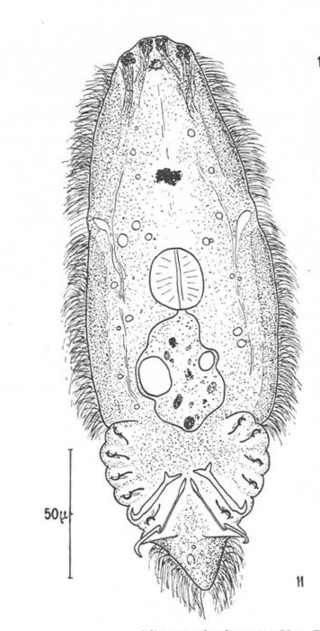
Microsporidia are a group of spore-forming unicellular parasites. These spores contain an extrusion apparatus that has a coiled polar tube ending in an anchoring disc at the apical part of the spore. They were once considered protozoans or protists, but are now known to be fungi, or a sister group to fungi. These fungal microbes are obligate eukaryotic parasites that use a unique mechanism to infect host cells. They have recently been discovered in a 2017 Cornell study to infect Coleoptera on a large scale. So far, about 1500 of the probably more than one million species are named. Microsporidia are restricted to animal hosts, and all major groups of animals host microsporidia. Most infect insects, but they are also responsible for common diseases of crustaceans and fish. The named species of microsporidia usually infect one host species or a group of closely related taxa. Approximately 10 percent of the species are parasites of vertebrates —several species, most of which are opportunistic, can infect humans, in whom they can cause microsporidiosis.
Elaeophora is a genus of parasitic nematodes which live attached to the interior surfaces of major arteries, veins and/or heart chambers in various large mammal hosts. Infestation with Elaeophora species is referred to as elaeophorosis. The species of Elaeophora have been found in Africa, Asia, Europe, and North America. Despite the fact that they produce aneurysms in the arteries and heart of their hosts which measure up to 2 cm in diameter, overt clinical symptoms of infestation are seldom reported, with the notable exception of E. schneideri infestation in sheep, elk, and moose.
Isospora is a genus of internal parasites in the subclass Coccidia.
Plasmodium atheruri is a species of the genus Plasmodium subgenus Vinckeia. As in all members of this genus, it is parasitic on vertebrate and insect hosts. The natural vertebrate host is the African porcupine but it is possible to infect the large vesper mouse and Meriones unguiculatus.
Dendrorhynchus is a gregarine genus with total 2 species. The genus was first described in 1920 by David Keilin from the alimentary canal of dolichopodid larvae Systenus.

Alexandre Joseph Émile Brumpt was a French parasitologist.

Onchocerca is a genus of parasitic roundworm. It contains one human parasite – Onchocerca volvulus – which is responsible for the neglected disease Onchocerciasis, also known as "river blindness" because the infected humans tend to live near rivers where host black flies live. Over 40 million people are infected in Africa, Central America, and South America. Other species affect cattle, horses, etc.
Opisthorchis is a genus of flukes in the family Opisthorchiidae.
Syndinium is a cosmopolitan genus of parasitic dinoflagellates that infest and kill marine planktonic species of copepods and radiolarians. Syndinium belongs to order Syndiniales, a candidate for the uncultured group I and II marine alveolates. The lifecycle of Syndinium is not well understood beyond the parasitic and zoospore stages.
Hematodinium is a genus of dinoflagellates. Species in this genus, such as Hematodinium perezi, the type species, are internal parasites of the hemolymph of crustaceans such as the Atlantic blue crab and Norway lobster. Species in the genus are economically damaging to commercial crab fisheries, including causing bitter crab disease in the large Tanner or snow crab fisheries of the Bering Sea.
Hepatocystis bainae is a species of parasitic alveolates belonging to the phylum Apicomplexa
Hepatocystis carpenteri is a species of parasitic protozoa. They are transmitted by flies of the genus Culicoides and infect mammals.
Hepatocystis brosseti is a species of parasitic protozoa that infect mammals. They are transmitted by flies of the genus Culicoides
Ellobiopsis is a genus of unicellular, ectoparasitic eukaryotes causing disease in crustaceans. This genus is widespread and has been found infecting copepods from both marine and freshwater ecosystems. parasitism has been seen to interfere with fertility in both sexes of copepods.
Legerella is a genus of parasitic alveolates of the phylum Apicomplexa. Species in this genus that usually infect the malpighian tubules of invertebrates.
Caulleryella is a genus of parasitic alveolates of the phylum Apicomplexa. Species in this genus infect insects (Diptera).
Pasteuria is a genus of mycelial and endospore-forming, nonmotile gram-positive bacteria that are obligate parasites of some nematodes and crustaceans. The genus of Pasteuria was previously classified within the family Alicyclobacillaceae, but has since been moved to the family Pasteuriaceae.
Allantocystis is a genus in the family Allantocystidae. Its only species is Allantocystis dasyhelei, a gregarine parasite of the larval biting midge Dasyhelea obscura.

Cystidicolidae is a family of spirurian nematodes. It was described by Skrjabin in 1946. All members of the family are parasites of fish.

An oncomiracidium is the ciliated and free-living larva of a monogenean, a type of parasitic flatworm commonly found on fish. It is similar to the miracidium of Trematoda, but has sclerotised (hardened) hooklets not found in the latter.




